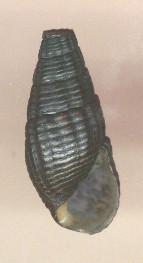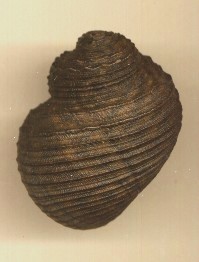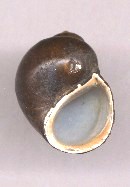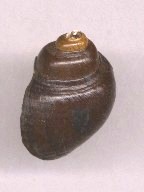|
|||||||||||||||||||||||||||||||||||||||
Freshwater Molluscan Shells / "Pleuroceridae"
Io fluvialis (Say, 1825) in habitat, northeast Tennessee, with several Leptoxis, in strong current.
There have been several attempts to re-introduce this species into suitable parts of its former range, with some success.
"Pleuroceridae": (Cerithioid snails not in families Thiaridae or Melanopsidae) Diverse in rivers of the Southeast United States. Many genera world wide. Burch in 1982 (note p. 196) discusses the various names that are applied to this family and concludes "...there is as yet no really solid basis for adequately comparing Pleurocera and its allies with Paludomus and its related taxa or Pachychilus and its relatives. Until the necessary comparative studies have been completed and evaluated, perhaps it is best to retain the family name Pleuroceridae."
Alternative classifications for the Pleuroceridae were considered by Banarescu (1990), who finally settled with the subfamilies and genera in the table below. Since that time, many genera have been reclassified, and several subfamilies have been raised to family status. Please see Bouchet and Rocroi (2009).
Pleurocerinae Pleurocera; American interior
Elimia; widespread, eastern North America
Lithasia; Ohio River drainage
Leptoxis; widespread, eastern North America
Io; endemic to Tennessee River and tributaries
Gyratoma; endemic to Coosa River
drainage, largely extinct
Juga; American far West and Northwest.
Holandriana; Danube River basin
Namruta; Japan
Amnipila; central Mexico
Pachychilus; Central and much of South America
Doryssa; eastern South America
Potadoma; central Africa
Potadomoides; southeastern Africa
Pachymelania; central AfricaLavigeriinae
Semisulcospira; East Asia and Japan
Lavigeria; Lake TanganyikaPaludominae
Paludomus; India and Southeast Asia
Chlorostracia; part of Burma
Cleopatra; Widespread Central Africa and Nile
Pseudocleopatra; tropical West Africa
additional genera endemic to Lake TanganyikaParamelaniinae = Tiphobiinae
Tiphobia; Lake Tanganyika.
Elimia catenaria (Say, 1822)
Atlantic coastal plain riversAccording to Dillon (2000), Pleuroceridae feed on detritus or the algae growing on hard surfaces, and many seem to be able to feed on both. The family is characterized by having two sexes, male and female, but with no outward expression of gender. Reproduction is iteroparous, meaning that they may do so several times throughout their multi-year lifespans. Fertilization may occur by males releasing sperm directly into the environment, as mating behaviour has never been observed. Eggs are laid on a hard surface, for example the underside of stones, and develop into tiny snails without a larval stage.
Lithasia snails with egg masses in a tributary of the Tennessee River, laid in early spring. slightly enlarged.
Photo by Mark Whited.
Syrnolopsidae, included for convenience with the African pleurocerids, but considered a seperate family.
Three genera endemic to Lake Tanganyika.
To North American Pleuroceridae
To African Pleuroceridae (Paludomidae, Potamididae, Syrnolopsidae)
Latin American Pleuroceridae (Pachychilidae)
Pachychilus indiorum (Morelet, 1849),
Central America. This, along with P. glaphyrus,
are the edible "jute snails" of the Mayas. Hundreds
have been found in archaeological sites along with
the clam Nephronaias ortmanni. (website)Kevin Cummings indicates these freshwater snails
are fairly widespread in Central America (Mexico,
Honduras, Belize, Guatemala), and Northern South
America (Venezuela). There are at least 111 described
taxa, many of which are recognized as synonyms.

Doryssa pernambucensis
(Reeve, 1861), BrazilDoryssa cachoeirae F. Baker, 1913 Brazil
Asian Cerithioid snails (Paludomidae and Semisulcospiridae)
Paludomus chilinoides Reeve 1847. Sri Lanka rivers. Preston (1914) lists
64 species and a number of varieties in four subgenera: typical Paludomus, (34
species); Philopotamus (9 species) Tanalia (20 species) and Stomatodon (1
species). Most are native to Sri Lanka, with some living elsewhere in Southern
and Southeast Asia. Brandt (1974) only lists one additional species for the
territory of Thailand. x4Paludomus neritoides
Reeve 1847. Sri Lanka.
Approx. natural size.
Large, thick shell, patterns
visible when backlit. In
subgenus Tanalia. x1.
Paludomus loricata (Reeve). This species is sold in Europe as an aquarium snail. Listed by
Preston, (1914) in the subgenus Tanalia, native to Sri Lanka "delighting in the most rapid
mountain torrents." Photo by Eduardo Diaz, Spain.
Paludomus regalis Layard, 1854. Sri Lanka. x 1.5.


Balanocochlis glandiformis (Schepman, 1896), and operculum, Malaysia.
Semisulcospira libertina
(Gould, 1858) TaiwanSemisulcospira reticulata
Kajiyama and Habe, JapanBiwamelania japonica (Smith, 1876)
Lake Biwa, Japan